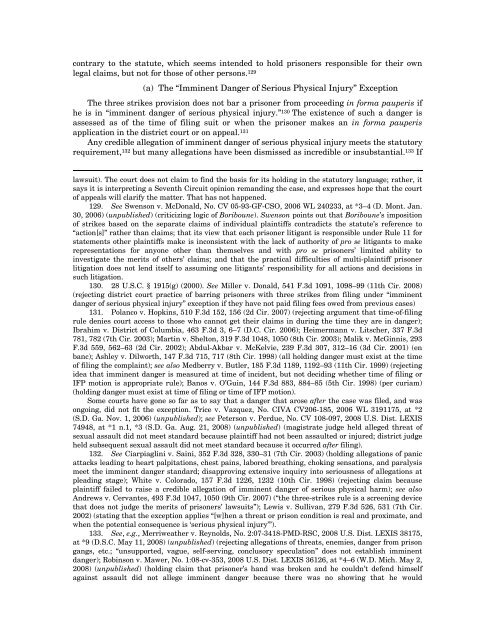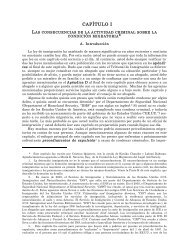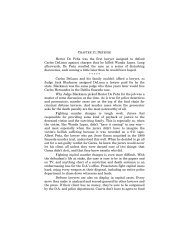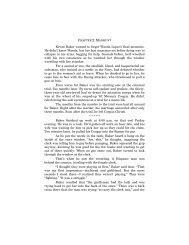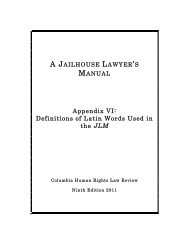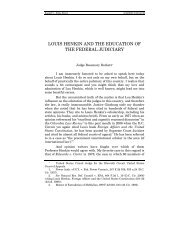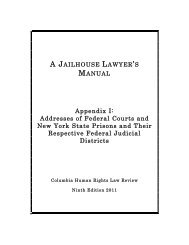A Jailhouse Lawyer's Manual Chapter 14 - Columbia Law School
A Jailhouse Lawyer's Manual Chapter 14 - Columbia Law School
A Jailhouse Lawyer's Manual Chapter 14 - Columbia Law School
You also want an ePaper? Increase the reach of your titles
YUMPU automatically turns print PDFs into web optimized ePapers that Google loves.
contrary to the statute, which seems intended to hold prisoners responsible for their own<br />
legal claims, but not for those of other persons. 129<br />
(a) The “Imminent Danger of Serious Physical Injury” Exception<br />
The three strikes provision does not bar a prisoner from proceeding in forma pauperis if<br />
he is in “imminent danger of serious physical injury.” 130 The existence of such a danger is<br />
assessed as of the time of filing suit or when the prisoner makes an in forma pauperis<br />
application in the district court or on appeal. 131<br />
Any credible allegation of imminent danger of serious physical injury meets the statutory<br />
requirement, 132 but many allegations have been dismissed as incredible or insubstantial. 133 If<br />
lawsuit). The court does not claim to find the basis for its holding in the statutory language; rather, it<br />
says it is interpreting a Seventh Circuit opinion remanding the case, and expresses hope that the court<br />
of appeals will clarify the matter. That has not happened.<br />
129. See Swenson v. McDonald, No. CV 05-93-GF-CSO, 2006 WL 240233, at *3–4 (D. Mont. Jan.<br />
30, 2006) (unpublished) (criticizing logic of Boriboune). Swenson points out that Boriboune’s imposition<br />
of strikes based on the separate claims of individual plaintiffs contradicts the statute’s reference to<br />
“action[s]” rather than claims; that its view that each prisoner litigant is responsible under Rule 11 for<br />
statements other plaintiffs make is inconsistent with the lack of authority of pro se litigants to make<br />
representations for anyone other than themselves and with pro se prisoners’ limited ability to<br />
investigate the merits of others’ claims; and that the practical difficulties of multi-plaintiff prisoner<br />
litigation does not lend itself to assuming one litigants’ responsibility for all actions and decisions in<br />
such litigation.<br />
130. 28 U.S.C. § 1915(g) (2000). See Miller v. Donald, 541 F.3d 1091, 1098–99 (11th Cir. 2008)<br />
(rejecting district court practice of barring prisoners with three strikes from filing under “imminent<br />
danger of serious physical injury” exception if they have not paid filing fees owed from previous cases)<br />
131. Polanco v. Hopkins, 510 F.3d 152, 156 (2d Cir. 2007) (rejecting argument that time-of-filing<br />
rule denies court access to those who cannot get their claims in during the time they are in danger);<br />
Ibrahim v. District of <strong>Columbia</strong>, 463 F.3d 3, 6–7 (D.C. Cir. 2006); Heimermann v. Litscher, 337 F.3d<br />
781, 782 (7th Cir. 2003); Martin v. Shelton, 319 F.3d 1048, 1050 (8th Cir. 2003); Malik v. McGinnis, 293<br />
F.3d 559, 562–63 (2d Cir. 2002); Abdul-Akbar v. McKelvie, 239 F.3d 307, 312–16 (3d Cir. 2001) (en<br />
banc); Ashley v. Dilworth, <strong>14</strong>7 F.3d 715, 717 (8th Cir. 1998) (all holding danger must exist at the time<br />
of filing the complaint); see also Medberry v. Butler, 185 F.3d 1189, 1192–93 (11th Cir. 1999) (rejecting<br />
idea that imminent danger is measured at time of incident, but not deciding whether time of filing or<br />
IFP motion is appropriate rule); Banos v. O’Guin, <strong>14</strong>4 F.3d 883, 884–85 (5th Cir. 1998) (per curiam)<br />
(holding danger must exist at time of filing or time of IFP motion).<br />
Some courts have gone so far as to say that a danger that arose after the case was filed, and was<br />
ongoing, did not fit the exception. Trice v. Vazquez, No. CIVA CV206-185, 2006 WL 3191175, at *2<br />
(S.D. Ga. Nov. 1, 2006) (unpublished); see Peterson v. Perdue, No. CV 108-097, 2008 U.S. Dist. LEXIS<br />
74948, at *1 n.1, *3 (S.D. Ga. Aug. 21, 2008) (unpublished) (magistrate judge held alleged threat of<br />
sexual assault did not meet standard because plaintiff had not been assaulted or injured; district judge<br />
held subsequent sexual assault did not meet standard because it occurred after filing).<br />
132. See Ciarpiaglini v. Saini, 352 F.3d 328, 330–31 (7th Cir. 2003) (holding allegations of panic<br />
attacks leading to heart palpitations, chest pains, labored breathing, choking sensations, and paralysis<br />
meet the imminent danger standard; disapproving extensive inquiry into seriousness of allegations at<br />
pleading stage); White v. Colorado, 157 F.3d 1226, 1232 (10th Cir. 1998) (rejecting claim because<br />
plaintiff failed to raise a credible allegation of imminent danger of serious physical harm); see also<br />
Andrews v. Cervantes, 493 F.3d 1047, 1050 (9th Cir. 2007) (“the three-strikes rule is a screening device<br />
that does not judge the merits of prisoners’ lawsuits”); Lewis v. Sullivan, 279 F.3d 526, 531 (7th Cir.<br />
2002) (stating that the exception applies “[w]hen a threat or prison condition is real and proximate, and<br />
when the potential consequence is ‘serious physical injury’”).<br />
133. See, e.g., Merriweather v. Reynolds, No. 2:07-3418-PMD-RSC, 2008 U.S. Dist. LEXIS 38175,<br />
at *9 (D.S.C. May 11, 2008) (unpublished) (rejecting allegations of threats, enemies, danger from prison<br />
gangs, etc.; “unsupported, vague, self-serving, conclusory speculation” does not establish imminent<br />
danger); Robinson v. Mawer, No. 1:08-cv-353, 2008 U.S. Dist. LEXIS 36126, at *4–6 (W.D. Mich. May 2,<br />
2008) (unpublished) (holding claim that prisoner’s hand was broken and he couldn’t defend himself<br />
against assault did not allege imminent danger because there was no showing that he would


